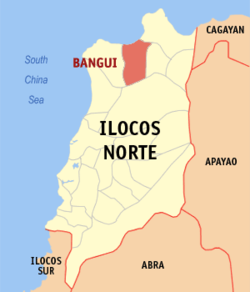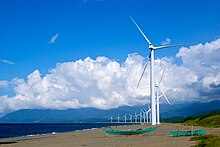Bangui, Ilocos Norte
Bangui | |
|---|---|
 View of Bangui from Sentinella Hill | |
 Map of Ilocos Norte with Bangui highlighted | |
Location within the Philippines | |
| Coordinates: 18°32′16″N 120°45′55″E / 18.5378°N 120.7653°E | |
| Country | Philippines |
| Region | Ilocos Region |
| Province | Ilocos Norte |
| District | 1st district |
| Barangays | 14 (see Barangays) |
| Government | |
| • Type | Sangguniang Bayan |
| • Mayor | Fidel A. Cimatu Jr. |
| • Vice Mayor | Denton Lawrence G. Garvida |
| • Representative | Ferdinand Alexander Araneta Marcos III |
| • Municipal Council | Members |
| • Electorate | 11,414 voters (2022) |
| Area | |
• Total | 112.98 km2 (43.62 sq mi) |
| Elevation | 88 m (289 ft) |
| Highest elevation | 902 m (2,959 ft) |
| Lowest elevation | 0 m (0 ft) |
| Population (2020 census)[3] | |
• Total | 15,019 |
| • Density | 130/km2 (340/sq mi) |
| • Households | 4,025 |
| Economy | |
| • Income class | 4th municipal income class |
| • Poverty incidence | 6.08 |
| • Revenue | ₱ 139.2 million (2020) |
| • Assets | ₱ 472.9 million (2020) |
| • Expenditure | ₱ 128.9 million (2020) |
| Service provider | |
| • Electricity | Ilocos Norte Electric Cooperative (INEC) |
| Time zone | UTC+8 (PST) |
| ZIP code | 2920 |
| PSGC | |
| IDD : area code | +63 (0)77 |
| Native languages | Ilocano Tagalog |
| Website | www |
Bangui, officially the Municipality of Bangui (Ilocano: Ili ti Bangui; Filipino: Bayan ng Bangui), is a municipality in the province of Ilocos Norte, Philippines. According to the 2020 census, it has a population of 15,019 people.[3]
The first power generating windmill farm in Southeast Asia, commonly known as Bangui Wind Farm, is found in the municipality of Bangui.
History
[edit]Bangui was first founded in 1786,[5] and was formally given its current status as a municipality in 1913.[6]
Bangui was one of the Ilocos region municipalities where various human rights violations were documented during the martial law era, despite public perception that the region was supportive of the Marcos administration.[7] Eight farmers in Bangui are documented to have been "salvaged" in 1984,[7] the same year as three indigenous community members in Vintar, while farmers from the towns of Vintar, Dumalneg, Solsona, Marcos and Piddig were also documented to have been tortured.[7]
The Bangui Wind Farm project of NorthWind Power Development Corp. (NorthWind) began commercial operation in 2005, eventually becoming a major tourist site for Bangui.[8] Ayala-owned AC Energy eventually took control of Northwind and of the Bangui Wind Farm in 2017, acquiring a total of 67.79% of Northwind stocks.[9]
Geography
[edit]Bangui is 554 kilometres (344 mi) from Metro Manila and 67 kilometres (42 mi) from Laoag City, the provincial capital.
Barangays
[edit]Bangui is politically subdivided into 14 barangays. [10] Each barangay consists of puroks and some have sitios.
- Abaca
- Bacsil
- Banban
- Baruyen
- Dadaor
- Lanao
- Malasin
- Manayon
- Masikil
- Nagbalagan
- Payac
- San Lorenzo (Poblacion)
- Taguiporo
- Utol
Dispute
[edit]On August 10, 2012, Barangay San Isidro was transferred to Dumalneg town based on the decision of Supreme Court over the disputed barangay.
Climate
[edit]| Climate data for Bangui, Ilocos Norte | |||||||||||||
|---|---|---|---|---|---|---|---|---|---|---|---|---|---|
| Month | Jan | Feb | Mar | Apr | May | Jun | Jul | Aug | Sep | Oct | Nov | Dec | Year |
| Mean daily maximum °C (°F) | 31 (88) |
32 (90) |
33 (91) |
34 (93) |
34 (93) |
34 (93) |
33 (91) |
32 (90) |
32 (90) |
33 (91) |
32 (90) |
31 (88) |
33 (91) |
| Mean daily minimum °C (°F) | 19 (66) |
20 (68) |
21 (70) |
23 (73) |
24 (75) |
24 (75) |
24 (75) |
24 (75) |
24 (75) |
23 (73) |
22 (72) |
21 (70) |
22 (72) |
| Average rainfall mm (inches) | 6.2 (0.24) |
11.7 (0.46) |
10.1 (0.40) |
14 (0.6) |
192.7 (7.59) |
258.9 (10.19) |
470.9 (18.54) |
475.9 (18.74) |
405.7 (15.97) |
92.5 (3.64) |
44.8 (1.76) |
2 (0.1) |
1,985.4 (78.23) |
| Average rainy days | 3 | 2 | 2 | 2 | 12 | 15 | 20 | 20 | 17 | 10 | 6 | 3 | 112 |
| Source: World Weather Online (modeled/calculated data, not measured locally)[11] | |||||||||||||
Demographics
[edit]
|
| |||||||||||||||||||||||||||||||||||||||||||||||||||
| Source: Philippine Statistics Authority[12][13][14][15] | ||||||||||||||||||||||||||||||||||||||||||||||||||||
In the 2020 census, the population of Bangui was 15,019 people,[3] with a density of 130 inhabitants per square kilometre or 340 inhabitants per square mile.
Economy
[edit]Poverty incidence of Bangui
5
10
15
20
25
30
2006
24.50 2009
12.63 2012
10.61 2015
8.52 2018
4.74 2021
6.08 Source: Philippine Statistics Authority[16][17][18][19][20][21][22][23] |
Government
[edit]Local government
[edit]
Bangui, belonging to the first congressional district of the province of Ilocos Norte, is governed by a mayor designated as its local chief executive and by a municipal council as its legislative body in accordance with the Local Government Code. The mayor, vice mayor, and the councilors are elected directly by the people through an election which is being held every three years.
Elected officials
[edit]| Position | Name |
|---|---|
| Congressman | Ria Christina G. Fariñas |
| Mayor | Fidel A. Cimatu Jr. |
| Vice-Mayor | Denton Lawrence G. Garvida |
| Councilors | Joy R. Soriano |
| Florencio G. Sales Jr. | |
| Diosdado I. Garvida | |
| Doddie M. Gaces | |
| Susan B. Faylogna | |
| Rogerick C. Balbag | |
| Anthony N. Campañano | |
| Florante L. Garvida |
Attractions
[edit]

Bangui is well known because of its wind farm, which is the town's main attraction. Although the Burgos and Caparispisan (Pagudpud) Windmills were built in 2013, many visitors still visit Bangui Windmills.
Bangui Bay is also a tourist spot, yet not practical for swimming because of its deepness and water currents, but it is beautiful to view. There is also Abang Falls that can be found in Barangay Lanao, also a tourist spot. Bangui is also good for its beautiful view of mountains and rivers.
Another important tourist attraction is the 400-year old St. Lawrence the Deacon Parish Church, located just adjacent to the Municipal Plaza. The Parish Church is currently under the parochial administration and management of the Congregation of the Rogationists of the Heart of Jesus (Rogationist Fathers), within the canonical jurisdiction of the Roman Catholic Diocese of Laoag. It still features the remains of the old church and the convent, whose institution was initiated by the Augustinians (Order of Saint Augustine - OSA).
Other attractions include:
- Municipal Plaza
- Bolo River (locally known Caramuangen River)
- Bangui Bay View Building
- Baruyen Dam
- Bangui's woodcraft windmills souvenir stores
- Suacan Spring
- Sentinella Hill
- Abang Falls
Notable personalities
[edit]- Gen. Roy Cimatu - Secretary of DENR, 2017-2022 and Chief of Staff of the Armed Forces of the Philippines, 2002
References
[edit]- ^ Municipality of Bangui | (DILG)
- ^ "2015 Census of Population, Report No. 3 – Population, Land Area, and Population Density" (PDF). Philippine Statistics Authority. Quezon City, Philippines. August 2016. ISSN 0117-1453. Archived (PDF) from the original on May 25, 2021. Retrieved July 16, 2021.
- ^ a b c Census of Population (2020). "Region I (Ilocos Region)". Total Population by Province, City, Municipality and Barangay. Philippine Statistics Authority. Retrieved 8 July 2021.
- ^ "PSA Releases the 2021 City and Municipal Level Poverty Estimates". Philippine Statistics Authority. 2 April 2024. Retrieved 28 April 2024.
- ^ "Ilocos Norte's windmills: Tourism and energy giants". Manila Standard. Archived from the original on 2021-10-08. Retrieved 2021-10-19.
- ^ Ferlin (2008-12-09). "Bangui". Museo Ilocos Norte. Archived from the original on 2020-09-29. Retrieved 2021-10-19.
- ^ a b c "Ilocanos remember dark days of martial law, vow to continue fight". 2 October 2012.
- ^ "AC Energy Corporation - NorthWind". AC Energy Corporation. Archived from the original on 2021-10-09. Retrieved 2021-10-19.
- ^ "AC Energy Takes Control of Northwind". AC Energy Corporation. 2017-02-05. Archived from the original on 2021-10-19. Retrieved 2021-10-19.
- ^ "Province: Ilocos Norte". PSGC Interactive. Quezon City, Philippines: Philippine Statistics Authority. Retrieved 12 November 2016.
- ^ "Bangui, Philippines: Average Temperatures and Rainfall". World Weather Online. Retrieved 15 September 2014.
- ^ Census of Population (2015). "Region I (Ilocos Region)". Total Population by Province, City, Municipality and Barangay. Philippine Statistics Authority. Retrieved 20 June 2016.
- ^ Census of Population and Housing (2010). "Region I (Ilocos Region)" (PDF). Total Population by Province, City, Municipality and Barangay. National Statistics Office. Retrieved 29 June 2016.
- ^ Censuses of Population (1903–2007). "Region I (Ilocos Region)". Table 1. Population Enumerated in Various Censuses by Province/Highly Urbanized City: 1903 to 2007. National Statistics Office.
- ^ "Province of Ilocos Norte". Municipality Population Data. Local Water Utilities Administration Research Division. Retrieved 17 December 2016.
- ^ "Poverty incidence (PI):". Philippine Statistics Authority. Retrieved December 28, 2020.
- ^ "Estimation of Local Poverty in the Philippines" (PDF). Philippine Statistics Authority. 29 November 2005.
- ^ "2003 City and Municipal Level Poverty Estimates" (PDF). Philippine Statistics Authority. 23 March 2009.
- ^ "City and Municipal Level Poverty Estimates; 2006 and 2009" (PDF). Philippine Statistics Authority. 3 August 2012.
- ^ "2012 Municipal and City Level Poverty Estimates" (PDF). Philippine Statistics Authority. 31 May 2016.
- ^ "Municipal and City Level Small Area Poverty Estimates; 2009, 2012 and 2015". Philippine Statistics Authority. 10 July 2019.
- ^ "PSA Releases the 2018 Municipal and City Level Poverty Estimates". Philippine Statistics Authority. 15 December 2021. Retrieved 22 January 2022.
- ^ "PSA Releases the 2021 City and Municipal Level Poverty Estimates". Philippine Statistics Authority. 2 April 2024. Retrieved 28 April 2024.
- ^ "2019 National and Local Elections" (PDF). Commission on Elections. Retrieved March 10, 2022.




